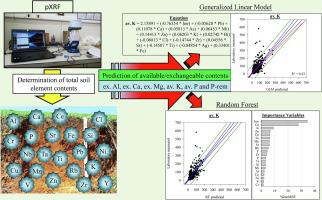Catena ( IF 5.4 ) Pub Date : 2020-11-03 , DOI: 10.1016/j.catena.2020.105003 Lucas Benedet , Salvador F. Acuña-Guzman , Wilson Missina Faria , Sérgio Henrique Godinho Silva , Marcelo Mancini , Anita Fernanda dos Santos Teixeira , Luiza Maria Pereira Pierangeli , Fausto Weimar Acerbi Júnior , Lucas Rezende Gomide , Alceu Linares Pádua Júnior , Igor Alexandre de Souza , Michele Duarte de Menezes , João José Marques , Luiz Roberto Guimarães Guilherme , Nilton Curi

|
Conventional soil fertility analyses are laborious, costly, time-consuming, and produce hazardous waste. The high demand of these laboratory-based analyses prompted us to investigate an environment-friendly, rapid, and inexpensive methodology for soil fertility assessment. Portable X-ray fluorescence (pXRF) spectrometry allows the determination of total elemental concentration in soils quickly, simply and without hazardous waste production. However, incipient usage of this technology for the prediction of soil fertility properties has been reported for tropical conditions. Soil samples were collected from seven Brazilian states (n = 1975) aiming to use pXRF data to predict contents of available or exchangeable Ca2+, Mg2+, Al3+, K+ and P by testing different algorithms using 70% of the samples for model training, and the remaining 30% for model validation. In addition to point data predictions, the best performing models were applied to data obtained from a farm within the studied regions with a known cropping history to create soil fertility maps and illustrate another applicability of this approach. The attested use of pXRF data and machine learning algorithms stepwise Generalized Linear Model (GLM) and Random Forest (RF) to predict the contents of relevant soil fertility properties exhibited great potential. Validation of the models corroborated that RF resulted in more accurate predictions than GLM. Validation R2 values ranged from 0.59 to 0.82. Maps created were coherent with expected distributions of soil fertility attributes. This environment-friendly methodology may be used for the assessment of soil fertility properties in a wide range of tropical and subtropical soils with minimum waste generation and reduced costs.
中文翻译:

利用X射线荧光数据和机器学习算法快速预测土壤肥力
常规的土壤肥力分析费力,昂贵,费时且产生有害废物。这些基于实验室的分析的高要求促使我们研究一种环境友好,快速且廉价的土壤肥力评估方法。便携式X射线荧光(pXRF)光谱仪可以快速,简单地测定土壤中的总元素浓度,而不会产生有害废物。然而,已经报道了该技术在热带条件下最初用于预测土壤肥力性质的用途。从七个巴西州(n = 1975)收集土壤样品,目的是使用pXRF数据预测可利用或可交换的Ca 2 +,Mg 2 +,Al 3+,K +的含量通过使用70%的样本用于模型训练,其余30%用于模型验证来测试不同的算法。除了预测点数据外,将性能最佳的模型应用于从研究区域内具有已知耕种历史的农场获得的数据,以创建土壤肥力图并说明该方法的另一种适用性。经过证明的pXRF数据和机器学习算法的逐步使用,广义线性模型(GLM)和随机森林(RF)来预测相关土壤肥力特性的含量具有巨大潜力。模型的验证证实了RF导致的预测比GLM更准确。验证R 2值范围从0.59到0.82。创建的地图与土壤肥力属性的预期分布保持一致。这种环境友好的方法可用于评估各种热带和亚热带土壤的土壤肥力特性,同时减少废物产生并降低成本。











































 京公网安备 11010802027423号
京公网安备 11010802027423号